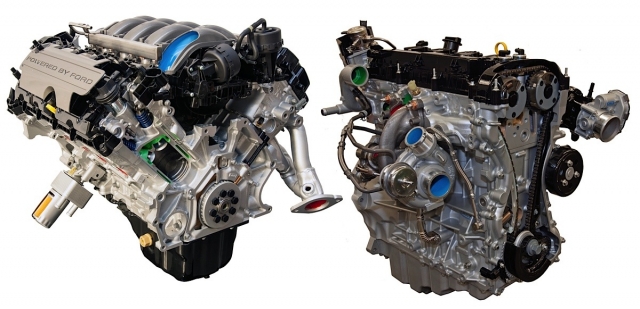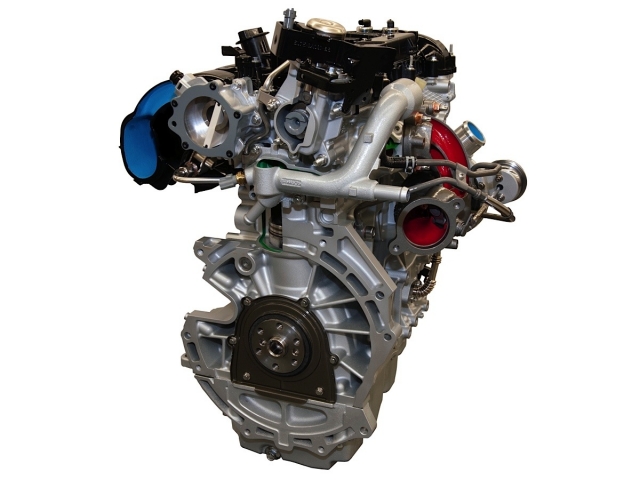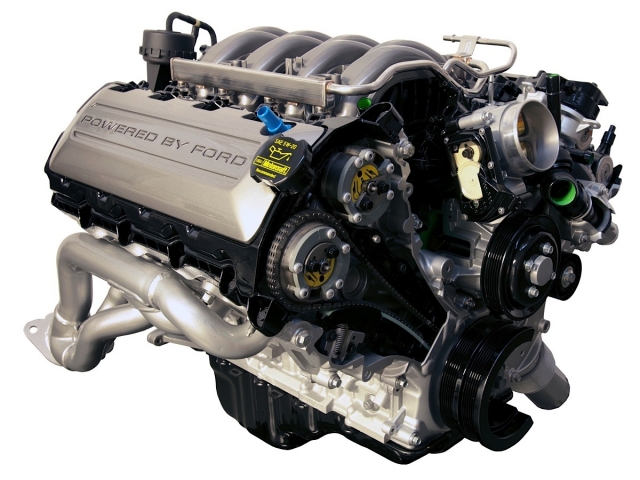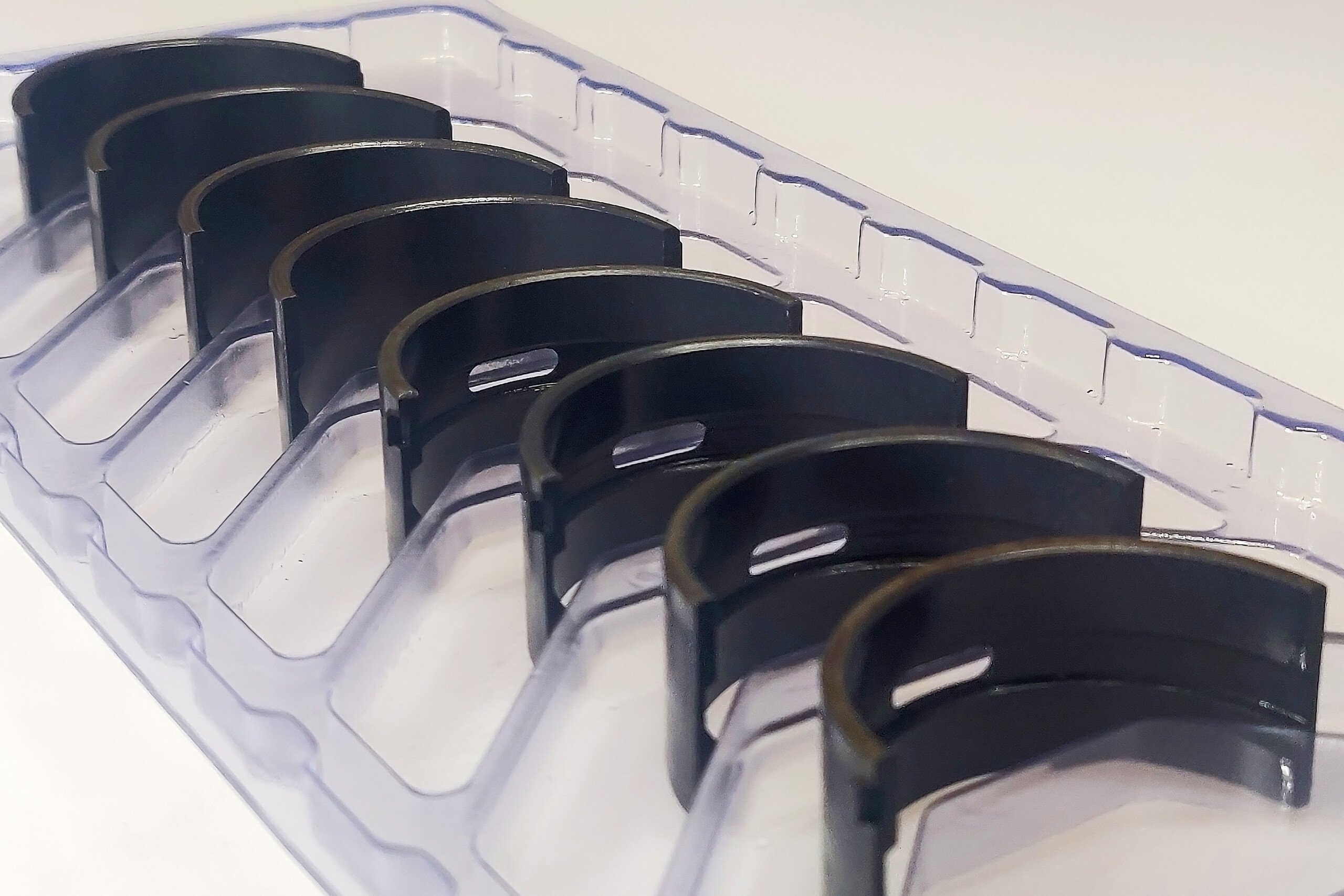 The next-generation 2015 Ford Mustang gets twin-scroll turbo power with the introduction of a new 2.3-liter EcoBoost inline-4 engine. It will be joined by an updated Coyote that features revised cylinder heads, more aggressive camshafts and an active intake manifold.
The next-generation 2015 Ford Mustang gets twin-scroll turbo power with the introduction of a new 2.3-liter EcoBoost inline-4 engine. It will be joined by an updated Coyote that features revised cylinder heads, more aggressive camshafts and an active intake manifold.
Ford didn’t release final horsepower numbers when the new Mustang made its public debut today, but projected the EcoBoost will offer 305-plus horsepower with around 300-plus lb-ft peak torque. The 5.0-liter V8 should generate more than 420 horsepower and twist around 390 lb-ft.
 Base engine for the new Mustang will be a 3.7-liter V6 with a projected 300 horsepower rating at 6,500 rpm and 270 lb-ft peak torque at 4,000 rpm.
Base engine for the new Mustang will be a 3.7-liter V6 with a projected 300 horsepower rating at 6,500 rpm and 270 lb-ft peak torque at 4,000 rpm.
The new EcoBoost is a stroked version of the 2.0-liter model. The bore remains the same at 87.5mm (3.45 inches), but the stroke is increased from 83.1mm (3.27 inches) to 94mm (3.7 inches) on the 2.3-liter version. Ford is also implementing a twin-scroll turbo for the first time. Popular with import performance cars, twin-scroll technology separates the inner and outer exhaust pulses with a cylinder head design that integrates the exhaust manifold.
Basically, the exhaust flow from cylinders 1 and 4 are separated from cylinders 2 and 3. This arrangement keeps the exhaust pulses from “interfering” with each other, as would be the situation if all the exhaust ports flowed into a single collector. The result preserves more of the exhaust pulse energy to spin the turbo wheel efficiently and reduce turbo lag. The separated exhaust ports also allow the exhaust valves to remain open longer for reduced pumping losses that Ford says improve specific fuel consumption by about one percent.
To address durability, Ford went with a forged-steel crankshaft and connecting rods inside a high-pressure die-cast aluminum cylinder block that has integrated main bearing caps. The cast pistons feature steel ring carriers and are cooled on the underside with oil squirters. A deep-sump die-cast oil pan acts as a structural member and includes baffles to maintain oil delivery in high-speed cornering or fast acceleration situations.
Other features familiar to EcoBoost engines include twin independent variable camshaft timing, direct injection and coil-on-plug ignition. Compression ratio is 9.5:1.
 For the 5.0-liter V8, Ford implemented a few tricks learned on the 2013 Boss 302 program. Most notably, the cylinder heads have been hogged out with larger valves and a revised intake port that provides a more direct flow for high-rpm flow. Ford engineers took advantage of this improved airflow by revising the cam specs (1mm more intake lift, 2mm additional exhaust lift) and adding stiffer valve springs. Ford also revised the piston design to take advantage of the new combustion chamber needed to accommodate the larger valves.
For the 5.0-liter V8, Ford implemented a few tricks learned on the 2013 Boss 302 program. Most notably, the cylinder heads have been hogged out with larger valves and a revised intake port that provides a more direct flow for high-rpm flow. Ford engineers took advantage of this improved airflow by revising the cam specs (1mm more intake lift, 2mm additional exhaust lift) and adding stiffer valve springs. Ford also revised the piston design to take advantage of the new combustion chamber needed to accommodate the larger valves.
Another trick was to include charge motion control valves (CMCV) to the intake manifold. With better breathing at high rpm, low-end torque can be adversely affected. By adding CMCV, the airflow is partially closed off, thereby increasing the charge rate to help boost low-rpm performance. Also manipulating the airflow is a variable cam timing mechanism with increased range of adjustment due to the addition of mid-lock phasers on the intake side.
Other features of the new 5.0-liter engine include rebalanced forged-steel crankshaft and sinter-forged connecting rods that were found in the Boss 302. Compression ratio is 11.0:1, and oil-pan capacity is eight quarts.


















